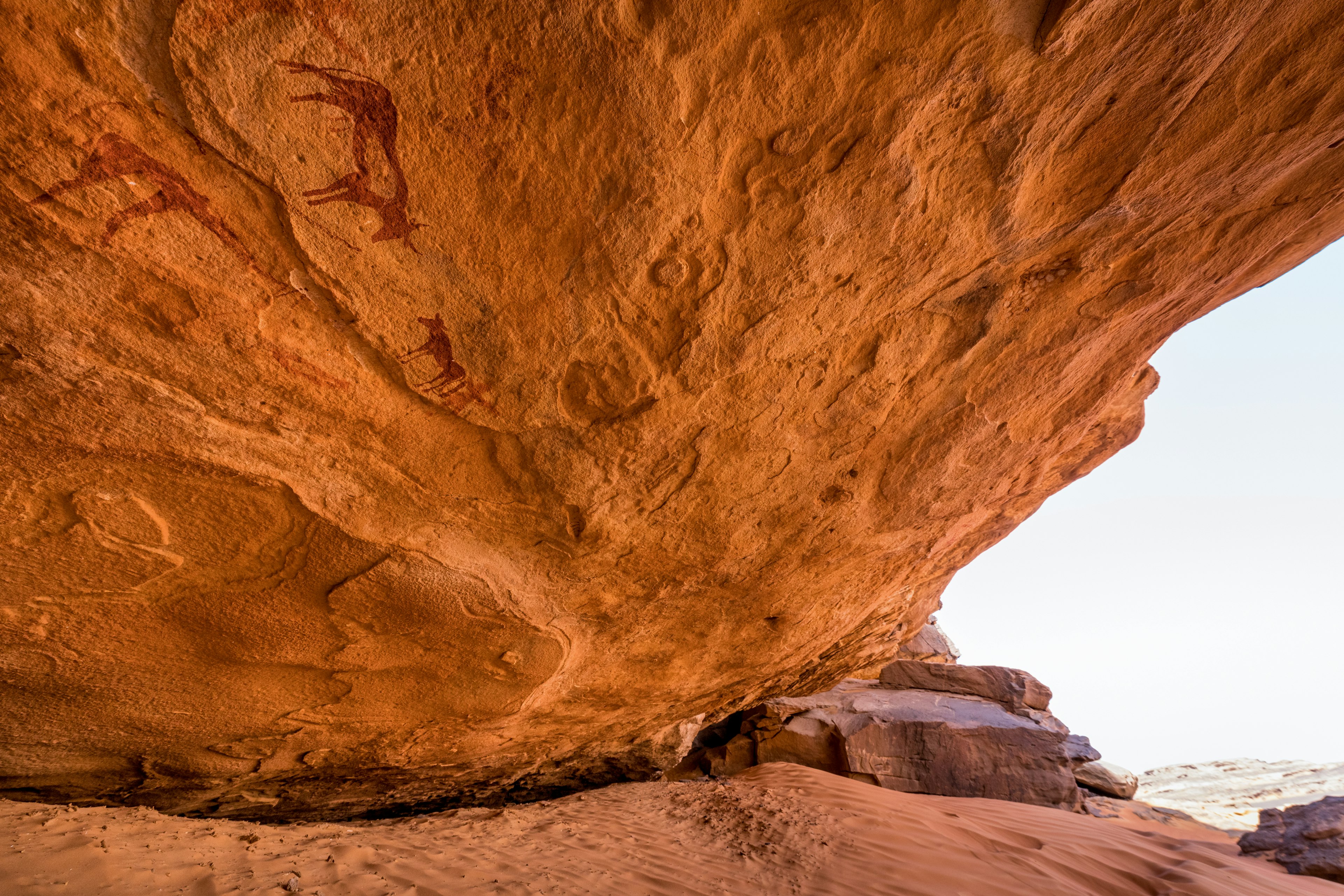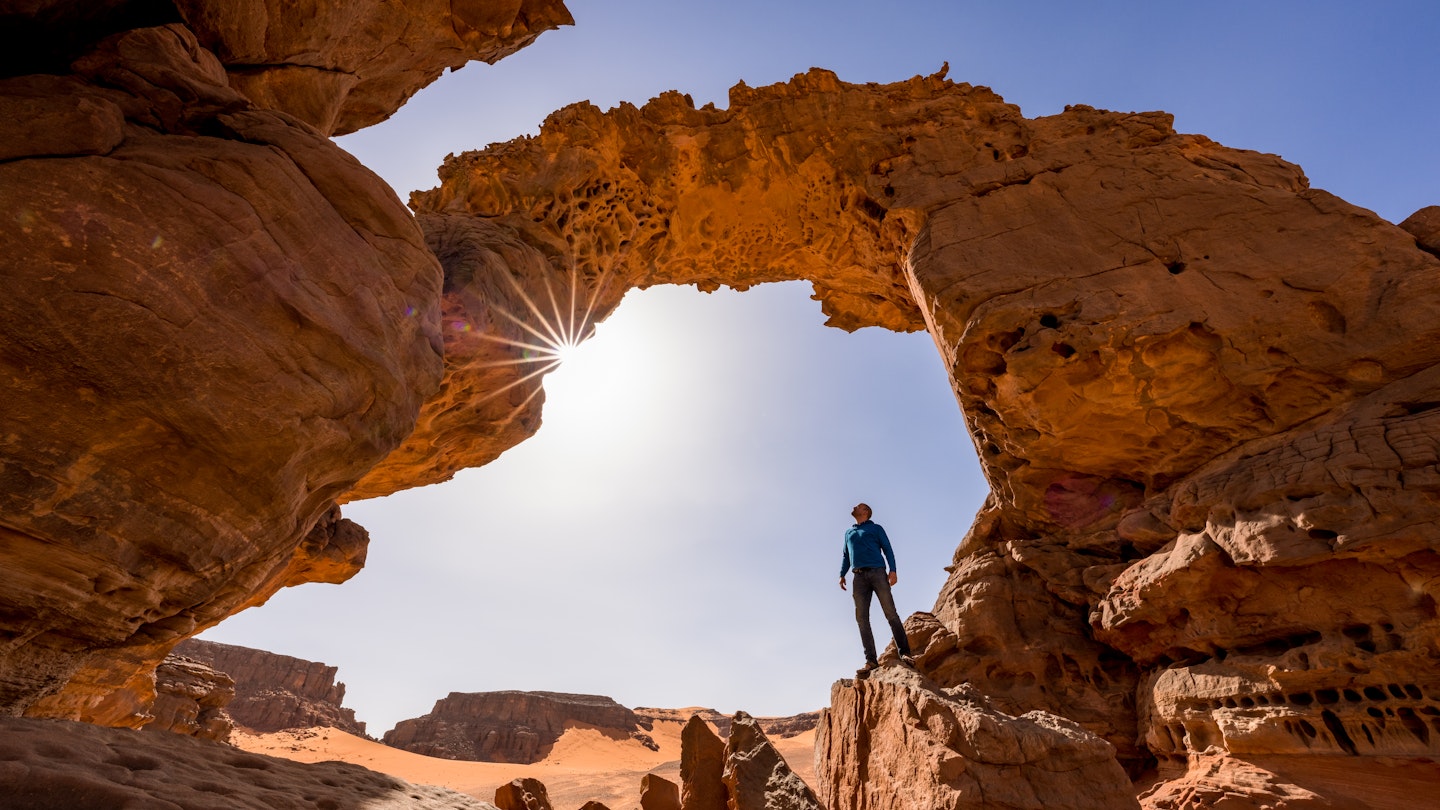Experience the Wonders of Tassili N’Ajjer National Park
On a visit to Algeria, writer Henry Wismayer and photographer Marcus Westberg venture into the country’s awe-inspiring (and seldom visited) interior.
The Hedgehog: A Geological Marvel
In a unique gulch, at the end of an arcade of russet outcroppings, stands The Hedgehog. Its uppermost dome resembles a carapace of rumpled stone, while its underside is smoothed by eons of wind and rain. This rock formation is improbably supported by three slender columns, with a stubby snout turned askance, as if sniffing the air. The surrealism of this natural artistry began to feel routine after two days in Tassili N’Ajjer.
If this is your first encounter with the name, you’re probably not alone. The truth is, I might not have found my way there if not for a message from a fellow writer, recently returned from Algeria, who enthusiastically encouraged me: “You must go to Tassili.”

Discovering Tassili N’Ajjer
Located in the southeast corner of Algeria, Tassili N’Ajjer National Park spans an impressive 72,000 square kilometers of the Sahara Desert, making it slightly larger than Ireland. Within this vast expanse, the desert reveals a breathtaking array of sandstone pinnacles, tabular mountains, and colossal dunes of colorful sand. UNESCO recognizes the park as a World Heritage Site, describing its otherworldly landscapes as “rock forests.”
As I flew over the golden expanse of Algeria’s interior on a two-hour flight south from Algiers, Tassili transformed in my imagination into a traveler’s grail, promising the freedom of having a vast tract of the planet to ourselves.

Upon landing at Djanet, Algeria’s southeastern outpost, we were met by our guide, Abdesalam Ayoub, or Salam for short. He wore a magenta headscarf, identifying him as Tuareg, a member of the dominant Berber tribe. We climbed into his friend’s age-old Landcruiser and traveled east along an empty asphalt road.
As we drove away, Salam explained the obscurity of Tassili was a mixture of geography and geopolitics. Its remote location in the heart of the Sahara, along with the nearby unstable borders of Libya and Niger, contribute to its scarce visitation by Western tourists.
Into the Rock Forests
By our second morning camping on the edge of the park, our routine was established: Salam and Lahcen, the driver, alongside Zaoui the cook, sat in front, while Marcus and I sat behind them, eagerly absorbing the landscape.
The immediate striking feature was the incredible topography—towering buttes, cascades of brown rock, expansive sand leading into amphitheaters of vertical rock, and countless caves perforating the mesas.
The ridgelines, sculpted by incessant winds, created a gallery of arches and balconies, inviting the human mind to see recognizable shapes in the random formations—honeycombs transforming into desert ziggurats or pillars resembling high-browed heads engaged in silent conversation.

A few miles past the military checkpoint marking the Tadrart Rouge, we arrived at a cliff base that seemed blank until we approached and discovered ancient depictions: a herd of cows, athletic hunters pursuing swine, and dappled giraffes. This marked the beginning of our exploration into one of the world’s richest concentrations of prehistoric rock art.
Primarily, the art is created with oxidized sandstone mixed with binding agents, depicting millennia of prehistory and evolutionary shifts prompted by the region’s arid climate.

The oldest artworks date back approximately 10,000 years, depicting megafauna such as elephants and giraffes, which thrived in a largely different climate than today. As desertification took hold, the artistic refinement ebbed as the nomadic lifestyle precluded prolonged artistic endeavors.
Wonders Revealed
As days passed, I felt we were amidst natural wonders akin to the world’s great awe-inspiring locales like Antarctica, Patagonia, and the Himalayas. Yet, during our second afternoon, strong sirocco winds carried orange dust, reducing visibility and softening the landscape’s textures.

The following morning offered clearer skies, revealing “The Cathedral” in resplendent detail with towering openings against a bright blue backdrop. Salam’s exclamation of “It’s a miracle!” echoed our amazement at the beauty unfolding.
During a subsequent walk through the valley, Salam noted the evidence of seasonal rains and encouraged us to release seeds for local wildlife, demonstrating the deep connection the Tuareg maintain with the land.

Throughout the desert, tracks of various animals told the story of a vibrant ecosystem. The day was filled with remarkable discoveries, including ancient glyphs and rocks fashioned into fantastical shapes by nature’s artistry.
In the evening, Marcus and I ascended Tin Merzouga, the tallest dune in the park, for a breathtaking view of the vast lowlands. The beauty of the terrain deepened as the sun set, an appreciation for the desert enveloping us.

In that moment, I recognized the desert’s call—its stillness alongside a sense of impermanence, showing how the landscape shifts gradually over time, a reminder of geological history.
Where the Desert Means Freedom
For the following days, we established a pattern: morning explorations led us to scenic locations for lunch and time to examine the land. The treasures we found ranged from ancient pottery shards to fossils, illustrating the layers of history embedded in the environment.

Upon returning to camp, Zaoui greeted us with thick coffee and aliwa, a nourishing wheat soup. The bond we formed with the guides showcased the Tuareg culture of hospitality and friendship. Their joyful interaction with both us and the local fauna enriched our experience.
Reflecting on our journeys, Lahcen shared his life story—the freedom he experienced as a nomad contrasted sharply with the constraints of modern borders. He lamented the fading of traditional lifestyles in favor of contemporary aspirations.

As the moon rose above, marking the transition to night, Lahcen prepared traditional Tuareg bread, reflecting the cultural richness of our experience. The meal was a satisfying culmination of our most recent adventures.
Paradise Lost
As we returned to the main road, the sensation of movement felt surreal after six days spent navigating the sandy terrain.

One last treasure awaited us on our journey back. At a cluster of outcrops, we witnessed the famous etching known as “the crying cows.” This poignant image served as a reminder of the rich history of the land and its connection to human emotion.
As we approached Djanet, my phone’s signal returned, contrasting sharply with the sanctuary we’d found in the stark beauty of Tassili. However, its calling card remained firmly etched in my heart—a place where nature’s solitude feels like a sanctuary amidst a tumultuous world.




